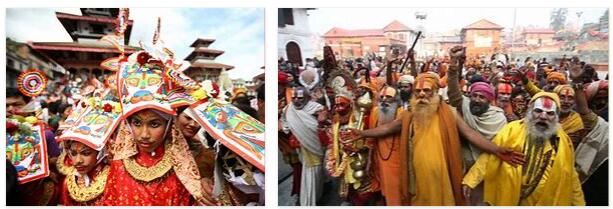A feast for dogs
Dogs are important animals in Nepal. The Nepali believe that dogs keep bad luck away from homes. Once a year there is a festival at which dogs are honored. This festival is called the Tihar festival. The dogs are painted and decorated with flowers. There are also very special treats on this day, so many dogs also accept the flower decorations.
… and for cows!
At the Tihar festival, not only dogs are worshiped, but also cows. Cows are a sign of prosperity. In addition to the dogs, other animals, such as crows, are also honored. These are important messengers for the Nepalis.
This festival is a festival of lights and thanksgiving. It always takes place in the month of Karttika, i.e. in October and November. At the same time, one worships a goddess who is called Lakshmi and who stands for the prosperity of the people in Nepal.
Tibetan New Year
Another festival is called Lhosar. This is the Tibetan New Year. From Tibet, it has spread to many parts of Nepal and ethnic groups such as the Tamang and the Sherpa. Most of the time the festival takes place during a new moon. During the festival, Buddhist traditions are carried out and, like us, a new beginning is celebrated.
The preparations for this start quite early. For example, you bake khaps together. It is a kind of New Year’s bread made from flour, oil, water and salt. By the way, the sweet variant is called Solmar. Before you start the new year in this way, a lot of other dishes are cooked and eaten together on the evening before Lhosar.
On the day of the event, people hang up prayer flags and pray together. The New Year is greeted by throwing barley in the air and shouting “Tiki Sasso Lhagyalo”. That means prosperity, health and joy, but not only for yourself, but for all living beings. Then you dance, laugh and eat together. The festival goes on for three days.
The Sherpa
There are many different ethnic groups and tribes in Nepal. They also include the Sherpa. They live in the east of Nepal and most of them profess Buddhism. The Sherpa are famous for being very good at mountaineering and very strong. The Sherpa live partly in steep mountain regions and have adapted to the conditions there. So it came about that mountain climbers paid more and more sherpas to carry luggage and give tips on the way. For some, the term Sherpa has become synonymous with a person who climbs a mountain with a lot of luggage.
The caste system
The caste system in Nepal is very similar to that in India, a country located in Asia according to allunitconverters. This is because the systems in the two neighboring countries developed at about the same time. The caste system is supposed to sort the people in a country, so to speak. You are assigned a kind of rank, which also determines what “value” you have in a society. However, this is quite unfair, because you are born into your caste and are then bound to that caste. There is no marriage between the castes. Actually, one shouldn’t discriminate against people from other castes because of their affiliation, but unfortunately that happens anyway.
Yeti
You may have heard of the Yeti, the snowman who has so many stories about. We do not know whether it exists or not. But the Sherpa believe in it and somehow the Yeti is simply part of the country’s culture. The Yeti is described as a two to three meter tall man who weighs more than 200 kilograms and whose feet are said to be up to 43 centimeters long. Some think it looks like a monkey.
Some see in him a kind of people who are not yet known and who somehow could survive in the mountains. Others believe that the Yeti is actually a bear, and in some Himalayan languages, Yeti means “bear”.
In any case, the Nepalese themselves believe in the Yeti, and many a tourist goes in search of the legendary figure. And tourism is an important source of income for the people in Nepal. That’s why we just sometimes believe that there may be a being in the high mountains who can hide so well that no one will ever really meet him. Let’s hope so for the Yeti.
